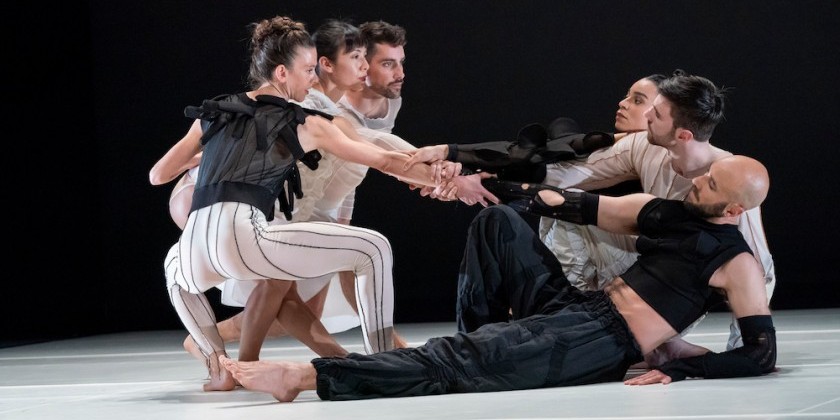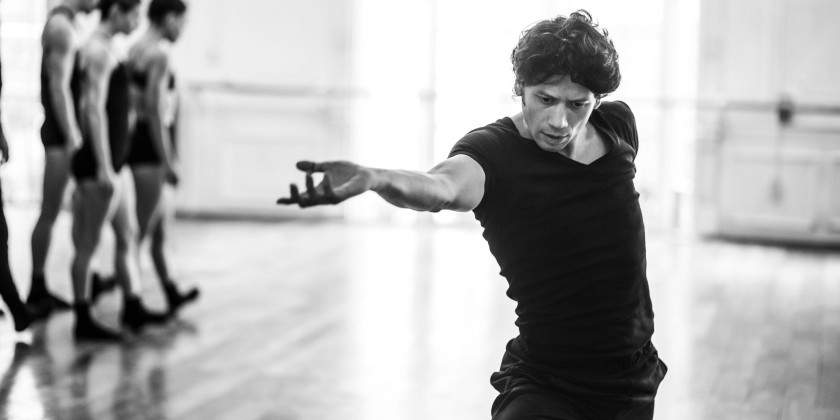IMPRESSIONS: Trisha Brown Dance Company at The Joyce Theater with a Guest Commission by Judith Sánchez Ruíz

Founding Artistic Director & Choreographer: Trisha Brown
Guest Choreographer: Judith Sánchez Ruíz
Dancers: Christian Allen, Cecily Campbell, Lindsey Jones, Burr Johnson, Cynthis Koppe, Patrick Needham, Jennifer Payán, Spencer James Weidie
Associate Artistic Director: Carolyn Lucas // Assistant Rehearsal Director: Cecily Campbell
They’ve done it. The Trisha Brown Dance Company has taken the plunge, and for the first time ever has commissioned a new work that does not bear the signature of its founder. Everyone can now take a deep breath, and look toward a future in which diversifying the repertoire becomes a normal, if always a risky, occurrence.
Let’s Talk About Bleeding, choreographed by Judith Sánchez Ruíz, received its premiere on May 2, at the Joyce Theater, as part of a too-brief run. Evidently, presenting Brown’s dances is still the company’s raison d’être, and the highlight of this single program was the revival of her teasing and mysterious For M.G.: The Movie (1991) — a masterwork if ever there was one. Rogues opened the bill, and this gorgeous duet, which Brown choreographed in 2011, contains sly tricks of its own.
In contrast to the spare look of both those pieces, Bleeding boasts outré costumes by Claire Fleury, a disjointed text, and a wide-ranging score by Adonis González-Matos, who plays some of it live on the piano. The recorded instruments, like Tricia Toliver’s lighting plan, create a series of environments. With these extravagant features, Bleeding seems intended as a whiz-bang finale. Yet while consistently interesting to watch, its effects feel labored.

In the opening, Burr Johnson (in black) and Patrick Needham (in white) crawl around each other swimming with their elbows. Their dialog results in a brief, back-to-back connection. Rising, they bump without grappling. When two women emerge, they also seem mismatched. After the men swing and release them, Jennifer Payán lies curled on the floor, gasping, next to Cecily Campbell, who rises on tip-toe (a contrast in level). When the whole cast has assembled, Johnson begins to speak, “You’re not little anymore,” he scolds someone; “I want to see the room,” and “It’s my kingdom.”
Much of the movement in Bleeding seems as disconnected as the text, with heads and limbs wagging or dangling; although at points the dancers come together. Reaching out to clasp hands, they weave a tense connection. At other times, individuals squeeze and wriggle their way out of a tight spot. The goal isn’t necessarily escape; when Cynthia Koppe frees herself, she turns to nuzzling the others.
Peaceful integration remains elusive until the end, when we see dancers reclining on their sides, each person’s head resting on the hip of the next in line. This lovely design shifts, as they look up, drop their heads, and then return to rest. At last, they fit together.

Brown achieves much more with a lighter hand. A ripple animates the dance partners in Rogues, setting in motion an unhurried duet in which Campbell and Johnson dance in unison, and then — oh, so sweetly — try to sneak ahead of each other. Soft, loose gestures contrast with the grid on the floor, emphasizing the dancers’ humanity as they bend low, rotate a shoulder, or stir the air. Restful pauses draw our attention to details. Toward the end, the duet grows more energetic, but never loses its easy-going attitude. Composer Alvin Curran conjures the atmosphere of a lazy, summer day with mechanical birdsong and the wheeze of a harmonica. Delightful!
The same composer is responsible for the music of For M.G.: The Movie. This score is a magical soundscape which, like the dance, abounds in small but fascinating incidents. Traffic rumbles, and metal clashes. A fly buzzes against a windowpane, and two neighbors hold a piano competition. One practices a rinky-dink tune and the other bangs out dissonance, the music floating intermittently from unseen apartments. The only “scenery,” however, is the striped shadow on the upstage wall (is someone peering through the blinds?), its angle shifting during the course of the dance, as if the sun were traveling overhead.
Into this rich, imaginary environment bounds a jogger, Spencer James Weidie, an indefatigable athlete (we all know the type) who swerves gracefully, and explores the limits of the space running up against the edge of the stage, and nosing into corners. Weidie dashes forward and backward along the same paths. The jogger leads us into a world of mystery, making us wonder what they see when gazing around or looking cautiously at the ground, and what unexpected obstacles arise causing Weidie to pull up short, or double-over with a sudden cramp.

Brown teases us with these invisible, pedestrian dramas, and with other images of dancers pausing to survey the scene, peering over “windowsills” they make with their extended arms. On one level, For M.G. is a dance about looking. We want to see more — maybe more than we ought to see — and if we don’t see what we want, we’ll make up something. How different, really, is the spectator sitting in a darkened theater from the garden-variety voyeur?
Jennifer Payán’s entrance takes place in dim lighting, only gradually revealing her whole figure; and Brown distracts us, so we miss the exact moment when Payán steps fully on stage. Suddenly, she’s just there. The choreographer never allows us to see the face of another character (Burr), who spends the whole dance standing in one spot with his back to us. Gazing at this stolid “Everyman’s” back reminds us, too, that when a dancer poses in profile, we only see one side. It doesn’t matter how slowly the dancers move — look away, and you miss something. As we become aware of these limitations, they enflame our desire to see, which quickly becomes obsessive. During For M.G.: The Movie, viewers dare not close their eyes. Time is fleeting.
Fortunately, there is so much we can see, all of it beautiful, including the place where dancers appear to wander too close to one another and narrowly escape an awkward encounter; and the actual collision that makes Christian Allen wobble dazedly. Dancers pair up to create gorgeous symmetries; and composite images coalesce so gently, with one dancer in a trio taking another by the hand, that these images appear natural not acrobatic. After Payán emerges into the light, she dances a knockout solo, swiveling, sinking, and stopping to pose with a pensive air. In spite of the welter of activity, the design remains limpid. With everything unnecessary pared away, For M.G. is a dance of heart-breaking perfection.












